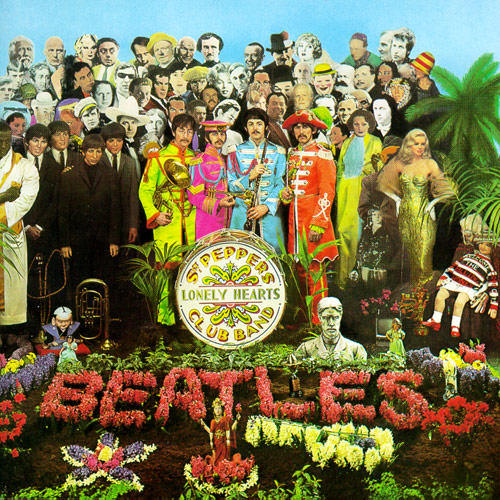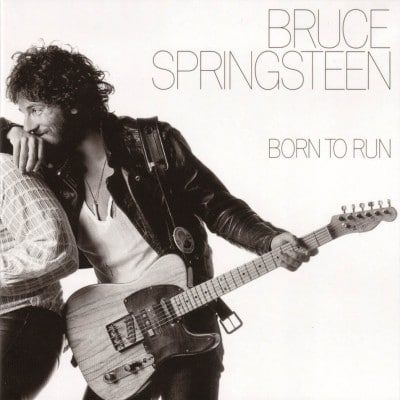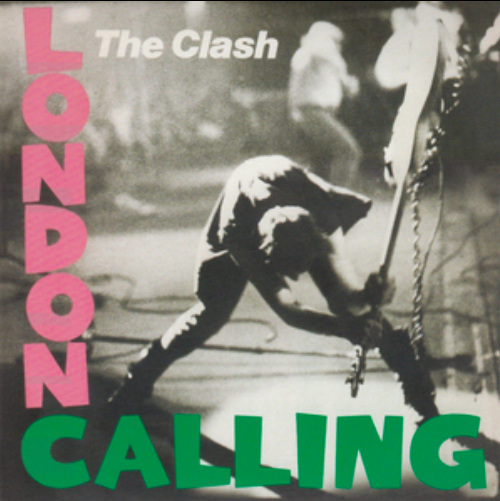Now that vinyl is making a comeback, we can once again marvel the wonder that is album art, specifically when it comes to the cover shot. Once upon a time, album covers were almost as highly anticipated as the music itself, as artists and bands tried to top each other with the next memorable image that would burn into the brains of fans for time immemorial. The newest albums certainly have a tough standard to meet, as the classic rock era produced some of the most iconic covers of all time. Here are five that stand out from the rest.
Videos by American Songwriter
1. Sgt. Pepper’s Lonely Hearts Club Band by The Beatles (1967)

The Beatles had a knack for being ahead of the curve withjust about every aspect of the music that they recorded and released. They were building toward something very special with their album covers, with the stretched-out image on Rubber Soul and the wild collage adorning Revolver, both released in 1966, setting the table. Since they were presenting themselves as a kind of doppelganger band with Sgt. Pepper’s, they imagined what it might be like for that group to give a performance and the who’s who that would show up. Hence, the idea to scour pop culture and history for an assemblage of figures to stand behind them in the cover photo. Cardboard cutouts of everyone from Bob Dylan to Dylan Thomas, from Lewis Carroll to Marlon Brando, from Karl Marx to Mae West, came to enjoy the show. In the center of it all was the band, in full Pepper regalia, looking like men who knew they had the goods on this record. The Beatles weren’t through with iconic covers, with the White Album and Abbey Road still to come, but the cover of Pepper’s captured not just a band, but an entire movement (The Summer of Love) in one glorious photo.
2. Led Zeppelin by Led Zeppelin (1969)

If you look online, you’ll probably find about ten or so different stories recollecting how Led Zeppelin got their iconic name. The most common one suggests that The Who’s John Entwistle, upon hearing who would comprise the band and what kind of music they intended to play, claimed that such an outfit would go over like a lead balloon. Once that inspired the name, it was a natural leap for Jimmy Page, who hand-picked the other members of the group (Robert Plant, John Paul Jones, and John Bonham), to play off it on the cover of the group’s debut, self-titled album. Hence, a photo of the Hindenburg, the doomed dirigible that exploded at the end of its trip from Germany to New Jersey in 1937. The image somehow also evoked the music found within, a massive explosion of sound that helped to define not only what Led Zeppelin would create for the next decade, but also a new genre called heavy metal.
3. Dark Side of the Moon by Pink Floyd (1973)

Pink Floyd was innovative right from the band’s inception with their use of visuals to enhance the music that they created. That included not only the lighting effects at their live shows, but also their album covers, which usually took an abstract approach. When it came to their 1973 album Dark Side of the Moon, a treatise on madness and how modern life can push even the most composed amongst us to the edge, the band enlisted their longtime collaborators Hipgnosis and asked for something simple. Chief designer Storm Thorgerson delivered an image of a prism refracting light. Simple indeed. But there was something about it that implied something vast and unknowable, a truth that can indeed blow out your brain. It would become the stuff of lava-lamp-lit basements and dorm rooms for generations.
4. Born to Run by Bruce Springsteen (1975)

For a no-nonsense type, Springsteen has delivered some unforgettable covers over the years. There’s the famous black-and-white shot of the plains on Nebraska or Annie Leibowitz’s photo of his backside on Born in the U.S.A. But Born to Run stands above them all by depicting the moment that Springsteen transformed from solo artist to musical gang leader. That gang was the E Street Band, and his right-hand man was saxophonist Clarence Clemons. Photographer Eric Meola took a bunch of shots of the two men with their instruments and landed one where Springsteen was leaning on The Big Man, as he was lovingly known. Springsteen is grinning with a look of something resembling awe in his eyes as Clemons prepares to let loose with a blast of brass. The way that it’s structured, with only Clemons’ arm visible on the front cover but fully displayed on the back, adds to the effect. It makes you wonder what’s keeping The Boss propped up, what keeps him from falling on his face. Turns out music and friendship does the trick.
5. London Calling by The Clash

The late ‘70s punk movement was a lot of things, so trying to sum it up in words is a devil of a task. But you can argue that a single image, the cover of The Clash’s masterpiece album London Calling, manages to do it quite well. Bassist Paul Simonon, in the midst of a gig in New York City and angry at bouncers who wouldn’t let the audience enjoy themselves with abandon, wound up and slammed his bass on the stage, shattering it to pieces. Photographer Pennie Smith’s shot captures Simonon in mid-swing, the damage not yet done but also not able to be prevented. It felt like The Clash’s sound and fury coalesced into a moment in time. Designer Roy Lowry added the icing on the cake by having the cover’s lettering and colors resemble Elvis Presley’s debut album cover. Was it an homage to the King, or was it a way of saying that punk was meant to destroy everything he had built? Either way, the image of Simonon’s destructive act shattered, so to speak, rock and roll norms and decorum in the most thrilling way possible.
